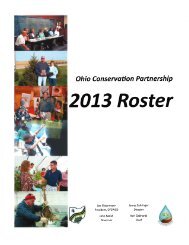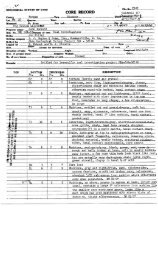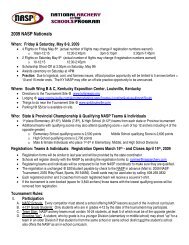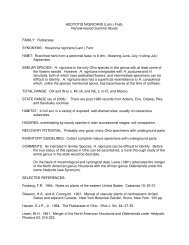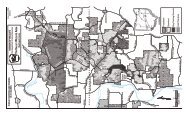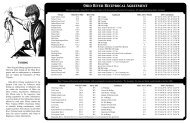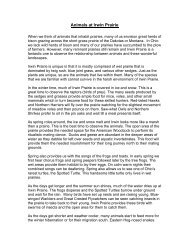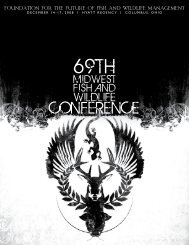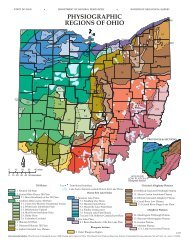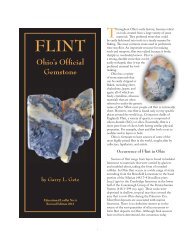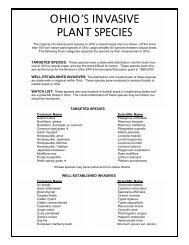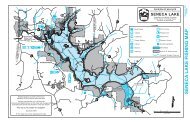MAMMALS OF OHIO f i e l d g u i d e
MAMMALS OF OHIO f i e l d g u i d e
MAMMALS OF OHIO f i e l d g u i d e
Create successful ePaper yourself
Turn your PDF publications into a flip-book with our unique Google optimized e-Paper software.
<strong>MAMMALS</strong> <strong>OF</strong> <strong>OHIO</strong> f i e l d g u i d e<br />
DIVISION <strong>OF</strong> WILDLIFE
About this Book<br />
Below are some helpful symbols for quick comparisons and identfication. They are<br />
Activity<br />
Diurnal • Most active during the day<br />
Nocturnal • Most active at night<br />
Crepuscular • Most active at dawn and dusk<br />
A word about diurnal and nocturnal classifications.<br />
In nature, it is virtually impossible to apply hard and<br />
fast categories. There can be a large amount of<br />
overlap among species, and for individuals within<br />
species, in terms of daily and/or seasonal behavior<br />
habits. It is possible for the activity patterns of<br />
mammals to change due to variations in weather,<br />
food availability or human disturbances. The<br />
designation of diurnal or nocturnal represent the<br />
most common activity patterns of each species.<br />
Tracks & Skulls<br />
Many mammals can be elusive to sighting, leaving<br />
only a trail of clues that they were present. Careful<br />
observation is required to detect their presence. A<br />
significant sign that a mammal resides or has passed<br />
through an area are the tracks they leave behind.<br />
This guide illustrates the tracks of the relevant species<br />
to help identify them in the field.<br />
located in the same place for each species throughout this publication. Definitions for<br />
the scientific terms used in this publication can be found at the end in the glossary.<br />
CARNIVORA<br />
Method of Feeding<br />
Carnivore • Feeds primarily on meat<br />
Herbivore • Feeds primarily on plants<br />
Insectivore • Feeds primarily on insects<br />
Omnivore • Feeds on both plants and meat<br />
description<br />
Gray or black in color with a pale<br />
gray underneath. The black mask<br />
is rimmed on top and bottom with<br />
white. The raccoon’s tail has four to<br />
six black or dark brown rings.<br />
habitat<br />
Raccoons live in wooded areas with<br />
big trees and water close by.<br />
reproduction<br />
Raccoons mate from February<br />
through March in Ohio. Typically<br />
only one litter is produced each year,<br />
but there can be exceptions to the<br />
rule. The young raccoons will stay<br />
with the female through the fall or<br />
winter.<br />
did you know?<br />
Male raccoons are called boars and<br />
females are called sows.<br />
© Ohio Division of Wildlife<br />
Raccoon<br />
Procyon lotor<br />
60
DIDELPHIMORPHIA5<br />
6 Virginia Opossum<br />
INSECTIVORA7<br />
8 Masked Shrew<br />
9 Least Shrew<br />
10 Smoky Shrew<br />
11 Pygmy Shrew<br />
12 Northern Short-tailed Shrew<br />
13 Eastern Mole<br />
14 Hairy-tailed Mole<br />
15 Star-nosed Mole<br />
CHIROPTERA16<br />
17 Little Brown Bat<br />
18 Big Brown Bat<br />
19 Rafinesque’s Big-eared Bat<br />
20 Northern Long-eared Bat<br />
21 Tri-colored Bat<br />
22 Red Bat<br />
23 Hoary Bat<br />
24 Silver-haired Bat<br />
25 Eastern Small-footed Bat<br />
26 Evening Bat<br />
27 Indiana Bat<br />
Table of Contents<br />
LAGOMORPHA28<br />
29 Eastern Cottontail Rabbit<br />
30 Snowshoe Hare<br />
RODENTIA31<br />
32 Eastern Chipmunk<br />
33 Thirteen-lined Ground Squirrel<br />
34 Eastern Gray Squirrel<br />
35 Fox Squirrel<br />
36 Red Squirrel<br />
37 Southern Flying Squirrel<br />
38 Woodchuck<br />
39 American Beaver<br />
40 Eastern Harvest Mouse<br />
41 Deer Mouse<br />
42 White-footed Mouse<br />
43 Allegheny Woodrat<br />
44 Meadow Vole<br />
45 Southern Red-backed Vole<br />
46 Pine Vole<br />
47 Prairie Vole<br />
48 Southern Bog Lemming<br />
49 Muskrat<br />
50 Norway Rat<br />
51 House Mouse<br />
52 Meadow Jumping Mouse<br />
53 Woodland Jumping Mouse<br />
54 Porcupine<br />
CARNIVORA55<br />
56 Coyote<br />
57 Red Fox<br />
58 Gray Fox<br />
59 Black Bear<br />
60 Raccoon<br />
61 Short-tailed Weasel<br />
62 Long-tailed Weasel<br />
63 Least Weasel<br />
64 Mink<br />
65 Badger<br />
66 River Otter<br />
67 Striped Skunk<br />
68 Bobcat<br />
ARTIODACTYLA69<br />
70 White-tailed Deer<br />
GLOSSARY71
What exactly makes an animal a<br />
mammal? First of all, all mammals<br />
have hair or fur. They also have<br />
endothermic (warm-blooded) bodies,<br />
meaning the body can stay at a nearly<br />
constant temperature, regardless<br />
of the outside environment. Most<br />
importantly, female mammals have<br />
mammary glands that produce milk<br />
for their offspring. Only mammals<br />
can provide nourishment to their<br />
young in this way. All of this should<br />
sound familiar because humans are<br />
mammals too!<br />
Although different species of<br />
mammals have certain characteristics<br />
in common, the mammalian class<br />
is still an incredibly diverse group.<br />
Mammals come in all sorts of shapes<br />
and sizes, the smallest being the<br />
pygmy shrew, weighing a mere onetenth<br />
of an ounce, and the largest<br />
being the blue whale, which can reach<br />
160 tons – that’s 352,740 pounds! A<br />
vast array of adaptations among<br />
Class Mammalia<br />
mammals allows different species<br />
to live very different lifestyles.<br />
Mammals that fly, glide, run, burrow,<br />
jump, or swim have evolved special<br />
morphologies, over time that allow<br />
them to do so. Such adaptations help<br />
them to exploit different habitats, so<br />
much so that mammals can be found<br />
on every continent and in every<br />
ocean on earth. In the state of Ohio<br />
alone, the diversity of mammals is<br />
evident and can be seen from the tiny<br />
mouse living in a barn to the big black<br />
bear lumbering through a forest.<br />
In this guide, the mammal orders<br />
appear in taxonomic order, meaning<br />
they are listed according to how they<br />
evolved in relation to each other. In<br />
other words, the more “primitive”<br />
groups are listed first and the<br />
“advanced” mammals are last. The<br />
Virginia opossum, a marsupial,<br />
has five fingers and toes, which is a<br />
characteristic that is considered to<br />
be very primitive among mammals.<br />
White-tailed deer, on the other<br />
hand, have a divided or split hoof<br />
considered to be more advanced in<br />
evolution. Fewer toes with hooves<br />
allow ungulates to take longer<br />
strides and run faster than flat-footed<br />
mammals with five toes.
DIDELPHIMORPHIA<br />
ORDER<br />
Didelphimorphia<br />
M<br />
arsupials are a fascinating<br />
group because their mode<br />
of reproduction is unique among<br />
mammals. A chief characteristic<br />
of marsupials is the presence of a<br />
marsupium, or pouch, on the abdomen<br />
of the females. Unlike most mammals,<br />
marsupials, such as opossums, are<br />
not fully developed when born. The<br />
premature young are equipped with<br />
tiny front legs so that they can crawl to<br />
the female’s pouch immediately after<br />
birth, where they will continue to grow<br />
and develop.<br />
Opossums are common inhabitants<br />
of the Western Hemisphere. They are<br />
among the oldest and most primitive<br />
mammals in the world. Opossums<br />
have long and scaly prehensile tails and<br />
an opposable toe on each foot that acts<br />
much like a thumb. These characteristics<br />
allow for a certain dexterity in<br />
opossums, which helps when climbing<br />
trees and invading trash cans.
DIDELPHIMORPHIA<br />
description<br />
An adult is about the size of a house<br />
cat, with coarse, grizzled, grayish fur.<br />
It has a long, scaly tail, ears without<br />
fur, and a long, pointed snout that<br />
ends in a pink nose.<br />
habitat<br />
Quite adaptable and can also be<br />
found in suburbia and the city. Ideal<br />
habitat, however, is an area with<br />
woods, wetlands, and farmland<br />
interspersed.<br />
reproduction<br />
A female opossum carries her<br />
young internally for approximately<br />
two weeks before they are born.<br />
Opossums are undeveloped and tiny<br />
(1/15 ounce) at birth. The offspring<br />
must crawl to a teat in the female’s<br />
pouch to survive. At about three<br />
months of age, young opossums<br />
emerge from the pouch for short<br />
periods and will hitch a ride on the<br />
adult female’s back to get from place<br />
to place.<br />
Virginia Opossum<br />
© Ohio Division of Wildlife<br />
Didelphis virginiana<br />
6<br />
did you know?<br />
The opossum is the only marsupial<br />
in North America.
INSECTIVORA<br />
ORDER<br />
Insectivora<br />
A<br />
s indicated by the order’s name,<br />
Insectivora, these animals feed<br />
primarily on insects. The insectivore<br />
group includes shrews and moles;<br />
small mammals that are rodent-like<br />
in appearance. Shrews and moles<br />
spend much of their time in dark,<br />
underground tunnels, thus having<br />
little need for the sense of sight.<br />
Because of this, the eyes are often<br />
very small and vision is reduced.<br />
Instead, these insectivores use their<br />
exceptional senses of smell and<br />
touch to get around and find food.
INSECTIVORA<br />
description<br />
The masked shrew is grayish-brown<br />
in color, with the under parts paler<br />
than the upper parts.<br />
habitat<br />
Masked shrews can be found in a<br />
variety of habitats, including forests,<br />
open country, and brushland.<br />
reproduction<br />
Masked shrews construct nests out<br />
of dry leaves and grasses, usually in<br />
stumps or under logs. They produce<br />
more than one litter per year with<br />
two to 10 young per litter.<br />
did you know?<br />
A shrew’s heart beats more than<br />
1,200 times per minute!<br />
Masked Shrew<br />
© Gary Meszaros<br />
Sorex cinereus<br />
8
INSECTIVORA<br />
description<br />
Fur is dense, velvety, and cinnamon<br />
in color. The color and extremely<br />
short tail help to distinguish it from<br />
other shrews.<br />
habitat<br />
Least shrews prefer open, grasscovered<br />
or brushy areas. It can also<br />
be found in marshes.<br />
reproduction<br />
Least shrews nest under debris,<br />
underground, and sometimes in<br />
beehives. In Ohio, they breed from<br />
March to November, with more than<br />
one litter per year, and about three to<br />
six young per litter.<br />
did you know?<br />
Unlike most shrews, the least is<br />
somewhat social. In the winter, more<br />
than one shrew may nest together for<br />
warmth.<br />
© Gregory G. Dimijian, MD / Photo Researchers Inc.<br />
Least Shrew<br />
Cryptotis parva<br />
9
INSECTIVORA<br />
description<br />
Uniformly dull brown except for a<br />
bicolored tail that is yellowish below<br />
and brown above. Its feet are pale in<br />
color.<br />
habitat<br />
Smoky shrews generally live in<br />
the leaf litter of birch and hemlock<br />
forests.<br />
reproduction<br />
After a gestation period of three<br />
weeks, two to seven naked, blind<br />
young are born in the spring.<br />
Another litter may be produced later<br />
in the summer.<br />
did you know?<br />
Smoky shrews travel and forage in<br />
underground tunnel systems, but<br />
they usually nest in stumps or logs.<br />
Smoky Shrew<br />
© Gary Meszaros<br />
Sorex fumeus<br />
10
INSECTIVORA<br />
description<br />
This tiny shrew has a pointed nose<br />
and narrow head. The hair is graybrown<br />
to gray with a lighter colored<br />
underbelly.<br />
habitat<br />
Pygmy shrews can live in a variety<br />
of habitats, including wooded<br />
and open areas, swamps, grassy<br />
clearings, and floodplains.<br />
reproduction<br />
Pygmy shrews produce one litter<br />
a year, between June and August,<br />
with three to eight young in a litter.<br />
The average gestation period is 19<br />
days.<br />
did you know?<br />
The pygmy shrew is the smallest<br />
living mammal. Its weight is about<br />
equal to that of a dime!<br />
Pygmy Shrew<br />
Sorex hoyi<br />
11<br />
© E.R. Degginger/ Photo Researchers, Inc.
INSECTIVORA<br />
Northern Short-tailed Shrew<br />
description<br />
Short, dense, slate-gray colored fur<br />
and a short tail. The snout is short<br />
and heavy.<br />
habitat<br />
These shrews are not restricted to a<br />
particular habitat, but they are most<br />
likely found in forests, grasslands,<br />
marshes, and brushy areas.<br />
reproduction<br />
The breeding season occurs from<br />
March to September with females<br />
producing up to three litters per<br />
year. Gestation periods usually last<br />
21 days and five to eight young are<br />
in a litter.<br />
did you know?<br />
The salivary glands of the Northern<br />
short-tailed shrew produce a toxic<br />
material which helps in subduing<br />
prey, such as snails and earthworms.<br />
© Ohio Division of Wildlife<br />
Blarina brevicauda<br />
12
INSECTIVORA<br />
description<br />
Broad front feet with the palms<br />
turned outward; lack of external<br />
ears. The tiny eyes are covered with<br />
a thin layer of skin. Their soft fur is<br />
a silvery to slate-gray color. The tail<br />
is hairless.<br />
habitat<br />
Eastern moles burrow underground<br />
in areas with moist, sandy loam soil<br />
such as lawns, golf courses, gardens,<br />
and fields.<br />
reproduction<br />
Breeding takes place in the spring.<br />
After a gestation period of about six<br />
weeks, four to five young are born.<br />
They live in a nest in the tunnel<br />
system with the female until they<br />
reach maturity at about one month<br />
of age.<br />
did you know?<br />
While the Eastern mole may cause<br />
damage to lawns and gardens, they<br />
also aerate the soil and eat unwanted<br />
insects.<br />
Eastern Mole<br />
© Ohio Division of Wildlife<br />
Scalopus aquaticus<br />
13
INSECTIVORA<br />
description<br />
Looks much like the Eastern mole,<br />
except it is smaller and has a<br />
distinctly hairy tail.<br />
habitat<br />
Hairy-tailed moles are found<br />
in sandy loam soils with good<br />
vegetative cover; they avoid heavy,<br />
wet soils.<br />
reproduction<br />
Hairy-tailed moles breed once or<br />
twice a year. After a gestation<br />
period of about four weeks, an<br />
average of four young are born.<br />
They live in a nest in the tunnel<br />
system with the female until they<br />
reach maturity at about one month<br />
of age.<br />
did you know?<br />
Underground tunnels may be used<br />
for eight years or more by many<br />
generations of these moles.<br />
Hairy-tailed Mole<br />
© D.C. Gordon/ American Soc. Mammalogists<br />
Parascalops breweri<br />
14
INSECTIVORA<br />
description<br />
Easily identified by its nose, which is<br />
surrounded by 22 fingerlike, fleshy<br />
tentacles. The body is dark brown or<br />
black and the tail is hairy.<br />
habitat<br />
Star-nosed moles inhabit low, wet<br />
soil near lakes or streams.<br />
reproduction<br />
Male and female star-nosed moles<br />
pair up in the fall and remain<br />
together throughout the mating<br />
season. Only one litter per year<br />
is produced with three to seven<br />
young being born between April<br />
and June.<br />
did you know?<br />
Unlike most moles, the star-nosed is<br />
semiaquatic, so many of its tunnels<br />
open under the surface of a stream<br />
or lake.<br />
Star-nosed Mole<br />
© Ohio Division of Wildlife<br />
Condylura cristata<br />
15
CHIROPTERA<br />
ORDER<br />
Chiroptera<br />
B<br />
ats are especially unique because<br />
they are the only group of<br />
mammals that have wings and can fly.<br />
A few other mammals have “gliding<br />
membranes” that allow them to soar<br />
through air for a short time, but they<br />
cannot truly fly like bats and birds.<br />
All Ohio bats are insectivorous and eat<br />
flying insects that they can catch on the<br />
wing, but some species in other parts<br />
of the world may feed on fruit, blood,<br />
or other vertebrates. Because bats are<br />
nocturnal and it is not easy to see in the<br />
dark, they use echolocation to navigate<br />
and find food at night. Bats echolocate<br />
by making high-pitched sounds which<br />
produce sound waves that bounce off<br />
objects in the environment. The bats<br />
listen to the returning echo to determine<br />
details about their surroundings.<br />
Bats typically mate in the fall, right<br />
before winter hibernation begins.<br />
However, ovulation and fertilization of<br />
the egg are delayed until the females<br />
awake from hibernation the following<br />
spring. This is referred to as delayed<br />
fertilization.
CHIROPTERA<br />
description<br />
The fur is uniformly dark brown<br />
on the upper parts, with slightly<br />
paler, grayish under parts. The wing<br />
membranes are dark brown.<br />
habitat<br />
Little brown bats are found in<br />
forested areas along streams and<br />
lakes. They are also found in urban<br />
and/or suburban areas.<br />
did you know?<br />
Bat s u se roost i ng sites (e.g.,<br />
trees, bat boxes, buildings) for<br />
pup rearing during the summer.<br />
Little Brown Bat<br />
© R. K. LaVal / American Soc. Mammalogists<br />
Myotis lucifugus<br />
17
CHIROPTERA<br />
description<br />
Uniformly medium to dark brown on<br />
the upper parts, with slightly paler<br />
under parts. The fur is relatively long<br />
and silky in appearance, compared to<br />
other Ohio bats. The ears and wing<br />
membranes are dark brown.<br />
habitat<br />
Big brown bats are found in a variety<br />
of habitats, including fields, forest<br />
openings, urban and/or suburban<br />
areas, and around water.<br />
did you know?<br />
Some bat species hibernate in caves,<br />
mines, or human-made structures,<br />
whereas other bat species hibernate<br />
in leaf litter or under tree bark during<br />
the winter.<br />
Big Brown Bat<br />
© Ohio Division of Wildlife<br />
Eptesicus fuscus<br />
18
CHIROPTERA<br />
Rafinesque’s Big-eared Bat<br />
description<br />
This species has exceptionally long<br />
ears and two large fleshy lumps on<br />
the nose, bordering the nostrils. The<br />
fur is long and silky.<br />
habitat<br />
These bats are found in forested<br />
areas. They roost in cave<br />
entrances, hollow trees, and crevices<br />
behind bark.<br />
did you know?<br />
Most bat pups are weaned and learn<br />
to fly at four to six weeks of age.<br />
© Merlin D. Tuttle / Bat Conservation International Inc.<br />
Corynorhinus rafinesquii<br />
19
CHIROPTERA<br />
description<br />
The fur is dull in color and their large<br />
ears extend slightly beyond the tip of<br />
the nose when laid forward.<br />
habitat<br />
Northern long-eared bats inhabit<br />
woods and can be found along<br />
wooded streams.<br />
did you know?<br />
During the summer, adult female<br />
bats form maternity colonies and<br />
adult male bats roost in solitary<br />
bachelor roosts.<br />
Northern Long-eared Bat<br />
© R.K. LaVal/ American Soc. Mammalogists<br />
Myotis septentrionalis<br />
20
CHIROPTERA<br />
description<br />
Varies in color from a pale yellowishbrown<br />
to a dark reddish-brown.<br />
The forearms are pinkish and the<br />
wing membrane is black. The ears<br />
are longer than they are wide. This<br />
species is the smallest of Ohio’s bats.<br />
habitat<br />
Tri-colored bats prefer open woods<br />
near water.<br />
did you know?<br />
Although young bats are altricial,<br />
they are able to make a clicking<br />
sound to signal the mother.<br />
Tri-colored Bat<br />
Perimyotis subflavus<br />
21<br />
© Ohio Division of Wildlife
CHIROPTERA<br />
description<br />
Males are bright red to reddishbrown<br />
in color and females are<br />
usually yellowish with a reddish<br />
tint. Dense, soft fur covers the body,<br />
including the uropatagium (the skin<br />
connecting its legs and tail).<br />
habitat<br />
Red bats roost among the foliage in<br />
forests, forest edges, and hedgerows.<br />
did you know?<br />
Some red bats, as well as other forest<br />
dwelling bats, travel to warmer<br />
southern states for the winter. The red<br />
bats that stay in Ohio for the winter<br />
burrow down into the leaf litter or<br />
roost within tree cavities. They may<br />
forage for insects on warm, sunny<br />
winter days.<br />
© Merlin D. Tuttle / Bat Conservation International Inc.<br />
Red Bat<br />
Lasiurus borealis<br />
22
CHIROPTERA<br />
description<br />
The largest bat in Ohio; its frosted<br />
appearance is because of its dark,<br />
white-tipped fur. Fur covers its body,<br />
including the uropatagium.<br />
habitat<br />
Hoary bats roost in the foliage of<br />
deciduous and coniferous forests.<br />
did you know?<br />
Because they are nocturnal, bats feed<br />
one hour or two after sunset and<br />
before sunrise.<br />
© Gary Retherford / Photo Researchers Inc.<br />
Hoary Bat<br />
Lasiurus cinereus<br />
23
CHIROPTERA<br />
description<br />
Can be easily identified by the frosted<br />
appearance made by its white-tipped<br />
black hairs.<br />
habitat<br />
Silver-haired bats are found in<br />
mature northern forests with ponds<br />
and streams nearby.<br />
did you know?<br />
Contrary to popular belief, attacks<br />
by bats are extremely rare.<br />
Silver-haired Bat<br />
© Merlin D. Tuttle / Bat Conservation International Inc.<br />
Lasionycteris noctivagans<br />
24
CHIROPTERA<br />
description<br />
Small with a black facial mask,<br />
small black ears, and small feet that<br />
measure 0.2-0.3 inches (6-8 mm) in<br />
length.<br />
habitat<br />
Eastern small-footed bats are found<br />
in deciduous and coniferous forests<br />
in hilly or mountainous areas.<br />
did you know?<br />
Contrary to popular belief, most bats<br />
do not carry rabies.<br />
Eastern Small-footed Bat<br />
© Ohio Division of Wildlife<br />
Myotis leibii<br />
25
CHIROPTERA<br />
description<br />
A medium-sized brown bat that<br />
looks like a smaller version of the big<br />
brown bat. The hairs on its back are a<br />
bronze-brown, whereas the hairs on<br />
its underside are slightly lighter. The<br />
muzzle is hairless and black.<br />
habitat<br />
Evening bats prefer forest and open<br />
habitats, such as river corridors and<br />
wetlands.<br />
did you know?<br />
The evening bat is a forest bat and is<br />
rarely found in caves.<br />
© Merlin D. Tuttle / Bat Conservation International Inc.<br />
Evening Bat<br />
Nycticeius humeralis<br />
26
CHIROPTERA<br />
description<br />
Similar in appearance to the little<br />
brown bat, but this species has<br />
shorter inconspicuous toe hairs and<br />
a keel on the calcar (cartilage near<br />
the tail).<br />
habitat<br />
Indiana bats are found in wooded or<br />
semi-wooded areas along streams.<br />
did you know?<br />
Contrary to popular belief, bats are<br />
not blind, nor are they interested in<br />
anyone’s hair.<br />
© Merlin D. Tuttle / Bat Conservation International Inc.<br />
Indiana Bat<br />
Myotis sodalis<br />
27
LAGOMORPHA<br />
ORDER<br />
Lagomorpha<br />
T<br />
he order Lagomorpha includes<br />
rabbits, hares, and pikas. Rabbits<br />
and hares are stout-bodied animals<br />
that resemble large rodents with<br />
short tails and long ears. Their big feet<br />
and strong hind legs are specialized<br />
for running and quickly escaping<br />
danger. Pikas are a similar animal<br />
found in the western U.S.<br />
Like rodents, rabbits and hares have<br />
two large incisors (front teeth) that<br />
continually grow and must be kept<br />
short by gnawing, or else they could<br />
grow too long and prevent eating.<br />
All species in the rabbit family are<br />
herbivores that feed on grasses and<br />
other plants.
LAGOMORPHA<br />
description<br />
A large rabbit with a brownish-gray<br />
body, long ears, and a small white<br />
tuft of a tail that resembles a cotton<br />
ball.<br />
habitat<br />
Open areas bordered by thickets<br />
or brushy areas. Rabbits prefer<br />
old fields with bunch grasses and<br />
weeds but will also be found in suburban<br />
areas if brushy escape cover is<br />
near.<br />
reproduction<br />
The nest is a shallow depression<br />
made in the ground, lined with dry<br />
grass and fur from the female’s body.<br />
The young are born helpless with<br />
very fine fur and closed eyes that do<br />
not open for four to five days. The<br />
female conceals the young in the<br />
nest and only returns once or twice<br />
per day to feed them.<br />
did you know?<br />
Cottontails can run at speeds up to<br />
18 miles per hour!<br />
Eastern Cottontail Rabbit<br />
© Ohio Division of Wildlife<br />
Sylvilagus floridanus<br />
29
LAGOMORPHA<br />
description<br />
Hares are larger than rabbits. Their<br />
hind feet can be up to seven inches<br />
long and have webbing between the<br />
toes. Their feet act like snowshoes to<br />
allow the hare to stay on top of the<br />
snow while running and jumping.<br />
During the winter, snowshoe hares<br />
have a thick white coat that helps<br />
them blend in with the snow. In the<br />
spring, they shed their winter fur<br />
and grow thin brown summer fur.<br />
habitat<br />
Hares are found in open fields, fence<br />
rows, swamps, riverside thickets,<br />
cedar bogs, and coniferous lowlands.<br />
reproduction<br />
Females may have up to four litters<br />
a year, depending on environmental<br />
conditions. The young hide in<br />
separate locations during the day<br />
and only come together for a few<br />
minutes at a time to nurse. The<br />
female cares for the young until they<br />
are about four weeks old, when they<br />
are weaned and disperse.<br />
Snowshoe Hare<br />
© Ohio Division of Wildlife<br />
Lepus americanus<br />
30<br />
did you know?<br />
Hares and rabbits are different in<br />
several ways: Young hares are born<br />
with fur, open eyes, and are able to<br />
run (precocial), but rabbits are born<br />
almost hairless with eyes closed<br />
(altricial) and don’t leave the nest for<br />
several weeks.
RODENTIA<br />
ORDER<br />
Rodentia<br />
R<br />
odents are the most numerous<br />
mammals, with over 2,000<br />
species in the world today. Although<br />
diverse, all rodents have incisors<br />
that grow continuously and must<br />
be kept short by gnawing.<br />
Many rodents, such as mice and<br />
voles, are important food sources<br />
for predators, making them a vital<br />
part of the ecosystem. Despite their<br />
popularity as prey, rodents are<br />
considered to be one of the most<br />
successful groups of mammals<br />
because of their high reproductive<br />
rate and ability to adapt to almost<br />
any environment.
RODENTIA<br />
description<br />
Reddish-brown in color with five<br />
black stripes on the back. These<br />
stripes are separated by brown,<br />
white, or gray colors.<br />
habitat<br />
Chipmunks inhabit many deciduous<br />
forests and brushy areas.<br />
reproduction<br />
Like others of the squirrel family, the<br />
Eastern chipmunk has two breeding<br />
seasons; one in early spring and the<br />
other in early summer. Four to five<br />
young are born after a gestation<br />
period of about 31 days.<br />
did you know?<br />
Eastern chipmunks do not hibernate<br />
continuously. Instead, they keep large<br />
stores of food in their burrows that<br />
they periodically snack on during<br />
the winter months.<br />
Eastern Chipmunk<br />
© Ohio Division of Wildlife<br />
Tamias striatus<br />
32
RODENTIA<br />
Thirteen-lined Ground Squirrel<br />
description<br />
Brown with 13 whitish stripes on<br />
the sides and back. They are small,<br />
measuring about seven to 12 inches<br />
long, including a three-to five-inch<br />
long tail.<br />
habitat<br />
These ground squirrels inhabit open<br />
short to mid-grass prairies and golf<br />
courses.<br />
reproduction<br />
Soon after hibernation ends in<br />
April, these squirrels mate. After a<br />
gestation period of 28 days, seven<br />
to 10 young are born. They mature<br />
quickly and leave the burrow after<br />
about a month. Females usually<br />
produce only one litter a year.<br />
did you know?<br />
The thirteen-lined ground squirrel<br />
hibernates about six months out of<br />
the year!<br />
© Mark Duffy / World of Stock<br />
Spermophilus tridecemlineatus<br />
33
RODENTIA<br />
description<br />
Gray with hairs that may have<br />
orange tips that will give the animal<br />
a reddish cast. Its belly is more of a<br />
grayish-white color.<br />
habitat<br />
Gray squirrels are found in large<br />
expanses of hardwood trees.<br />
reproduction<br />
Gray squirrels running up and down<br />
and around trees is thought to be a<br />
part of the courtship ritual. Young<br />
squirrels are reared in leaf nests,<br />
dens, and occasionally bird houses.<br />
Squirrels usually breed twice a year;<br />
in winter and in summer.<br />
did you know?<br />
Squirrels use two types of nests:<br />
leaf and den. Leaf nests are<br />
located in the crotches of tree<br />
branches and dens are formed in<br />
hollow tree trunks or branches.<br />
Eastern Gray Squirrel<br />
© Ohio Division of Wildlife<br />
Sciurus carolinensis<br />
34
RODENTIA<br />
description<br />
Slightly larger than the gray squirrel,<br />
the fox squirrel’s body is a yellowish<br />
gray with a reddish-yellow belly,<br />
cheeks, and feet. Tufts behind the ears<br />
and the tips of its tail are yellowishbrown.<br />
The tail itself is a reddishorange<br />
with a mixture of dark gray<br />
or black hairs throughout.<br />
habitat<br />
Fox squirrels inhabit deciduous and<br />
mixed forests.<br />
reproduction<br />
Fox squirrels usually mate twice a<br />
year; in December and June. A litter<br />
of two to three young are born after<br />
about 44 days. They are helpless and<br />
rely on the female’s milk for at least<br />
five weeks.<br />
did you know?<br />
When a fox squirrel is threatened, it<br />
stands upright with its tail over its<br />
back, flicking it.<br />
© Ohio Division of Wildlife<br />
Fox Squirrel<br />
Sciurus niger<br />
35
RODENTIA<br />
description<br />
The red squirrel is the smallest tree<br />
squirrel in Ohio. It has a uniformly<br />
yellowish or reddish coat and a<br />
whitish belly. The tail is bushy.<br />
habitat<br />
Red squirrels are found in coniferous<br />
and mixed forests.<br />
reproduction<br />
Red squirrels breed April-May and<br />
August-September. Two to seven<br />
young are born per litter after a<br />
gestation period of 38 days.<br />
did you know?<br />
Red squirrels store conifer cones in<br />
middens, or piles, instead of burying<br />
them like their larger cousins do. The<br />
middens made by red squirrels can<br />
be up to 30 feet across and 1.5 feet<br />
deep!<br />
© Ohio Division of Wildlife<br />
Red Squirrel<br />
Tamiasciurus hudsonicus<br />
36
RODENTIA<br />
description<br />
Easily distinguished by a “gliding<br />
membrane,” which is a flap of loose<br />
skin that extends from wrist to<br />
ankle. When outstretched, this skin<br />
allows the squirrel to glide from tree<br />
to tree. The fur is an olive-brown<br />
color on the upper parts and white<br />
on the under parts.<br />
habitat<br />
Southern flying squirrels<br />
inhabit woodlands or forests<br />
of deciduous or mixed<br />
deciduous-coniferous trees.<br />
reproduction<br />
Breeding takes place twice a<br />
year, once between February and<br />
March and again between May<br />
and July. After a gestation period of<br />
about 40 days, two to six young are<br />
born.<br />
did you know?<br />
Most people don’t realize that the<br />
flying squirrel is the most common<br />
squirrel in Ohio because it is<br />
nocturnal and seldom seen.<br />
Southern Flying Squirrel<br />
© Ohio Division of Wildlife<br />
Glaucomys volans<br />
37
RODENTIA<br />
description<br />
The coarse fur is usually grizzled<br />
grayish-brown with a reddish cast.<br />
The legs and feet are typically dark<br />
brown to black in color and are well<br />
suited for digging.<br />
habitat<br />
Woodchucks prefer open grasslands,<br />
pastures, and woodlands<br />
where it is easy to see predators such<br />
as humans, hawks, or coyotes.<br />
reproduction<br />
Immediately after coming out of<br />
hibernation in the spring, the male<br />
seeks a mate. The female gives birth<br />
to two to seven young that grow<br />
rapidly. By midsummer the female<br />
will drive the young off into nearby<br />
burrows, but she will continue to<br />
care for them until they develop<br />
territories of their own.<br />
did you know?<br />
Woodchucks a re also called<br />
groundhogs or whistlepigs.<br />
© Ohio Division of Wildlife<br />
Woodchuck<br />
Marmota monax<br />
38
RODENTIA<br />
description<br />
Beavers are large furbearers with<br />
webbed feet, a flattened, paddle-like<br />
tail, and huge front teeth. They also<br />
have transparent eye membranes<br />
and closable nostrils and ears;<br />
adaptations suited for an aquatic<br />
existence.<br />
habitat<br />
Beavers are found in forested ponds,<br />
lakes, and rivers.<br />
reproduction<br />
Beavers are generally monogamous;<br />
young are born between April and<br />
July, after a gestation period of<br />
about 128 days. The kits are<br />
born furred, with their eyes<br />
open, and are able to swim<br />
within 24 hours.<br />
did you know?<br />
The beaver is North America’s largest<br />
rodent, weighing up to 60 pounds!<br />
They eat bark and cambium, which<br />
is the softer growing tissue under<br />
the bark of trees.<br />
American Beaver<br />
© Ohio Division of Wildlife<br />
Castor canadensis<br />
39
RODENTIA<br />
description<br />
A rich, brown color, but the belly<br />
and the underside of the tail are<br />
paler than the back.<br />
habitat<br />
The Easter n harvest mouse<br />
i n habits old fields, marshes,<br />
a nd wet meadows.<br />
reproduction<br />
The baseball-sized, spherical nests<br />
are constructed on the ground out of<br />
shredded grasses. After a gestation<br />
period of about 21 days, a litter of<br />
two to five young is born between<br />
May and November.<br />
did you know?<br />
The Eastern harvest mouse is an<br />
excellent climber, and may spend<br />
a good<br />
deal of its time foraging<br />
above ground in dense<br />
vegetation.<br />
Eastern Harvest Mouse<br />
© R. W. Van Devender / American Soc. Mammalogists<br />
Reithrodontomys humulis<br />
40
RODENTIA<br />
description<br />
About the size of a common house<br />
mouse. Their color ranges from a<br />
pale gray to a deep reddish brown.<br />
The tail is always sharply bicolored;<br />
it is white below and dark above.<br />
habitat<br />
Inhabits nearly every dry-land habitat<br />
within its range. They can be found<br />
in forests, grasslands, brushlands,<br />
agricultural fields, and deserts.<br />
reproduction<br />
Deer mice will nest in burrows, trees,<br />
and buildings. The average litter has<br />
five or six young. Usually two to<br />
four litters are produced each year.<br />
The young are altricial at birth but<br />
develop very quickly.<br />
did you know?<br />
When disturbed, deer mice may<br />
drum their front paws rapidly up<br />
and down against a hard surface;<br />
this may serve as a warning signal to<br />
other deer mice.<br />
Deer Mouse<br />
© Gary Meszaros<br />
Peromyscus maniculatus<br />
41
RODENTIA<br />
description<br />
The upper parts are a pale to rich<br />
reddish-brown. Its belly and feet are<br />
white. The tail is usually shorter than<br />
the entire length of the body.<br />
habitat<br />
Inhabits a variety of areas, but most<br />
often found in woody or brushy<br />
areas.<br />
reproduction<br />
This mouse produces two to four<br />
litters per year during the breeding<br />
season, which occurs between March<br />
and June. A litter of two to six young<br />
are born after a gestation period of 22<br />
to 28 days.<br />
did you know?<br />
A distinctive behavior of whitefooted<br />
mice is drumming on a<br />
hollow reed or a dry leaf with their<br />
front paws to produce a long musical<br />
buzzing.<br />
White-footed Mouse<br />
© Ohio Division of Wildlife<br />
Peromyscus leucopus<br />
42
RODENTIA<br />
description<br />
Roughly the size of a gray squirrel;<br />
the body is brownish-gray in color<br />
and the undersides and feet are<br />
white. The tail is completely covered<br />
with hair and is blackish gray above,<br />
white underneath.<br />
habitat<br />
Allegheny woodrats can be found<br />
in rocky outcrops, such as cliffs and<br />
caves, in forested areas.<br />
reproduction<br />
Woodrats nest in rock crevices and<br />
usually produce three litters a year.<br />
did you know?<br />
The Allegheny woodrat’s whiskers<br />
are so long that when pulled back,<br />
they reach the shoulders. This<br />
characteristic sets it apart from other<br />
rats.<br />
Allegheny Woodrat<br />
© Ohio Division of Wildlife<br />
Neotoma magister<br />
43
RODENTIA<br />
description<br />
Dark brown in color with a silvery to<br />
slightly buffy or dark gray belly and<br />
bi-colored tail. The fur is long and<br />
soft.<br />
habitat<br />
The most widely distributed of the<br />
voles; can be found in meadows,<br />
fields, grassy marshes, and other<br />
places near streams, lakes, and<br />
swamps.<br />
reproduction<br />
Meadow voles breed year-round<br />
with litters of one to nine after a<br />
gestation period of 21 days.<br />
did you know?<br />
Meadow voles a re excellent<br />
swimmers!<br />
Meadow Vole<br />
© Gary Meszaros<br />
Microtus pennsylvanicus<br />
44
RODENTIA<br />
Southern Red-backed Vole<br />
description<br />
Distinguished from other voles by<br />
its reddish back and gray sides.<br />
habitat<br />
These voles prefer damp areas in<br />
coniferous, deciduous, or mixed<br />
forests.<br />
reproduction<br />
Females produce two or three litters<br />
a year, usually between March and<br />
October, with four to six young per<br />
litter. The gestation period is 17-19<br />
days.<br />
did you know?<br />
When disturbed, red-backed voles<br />
utter a chirplike bark that can be<br />
heard three to six feet away.<br />
Clethrionomys gapperi<br />
45<br />
© Robert J. Erwin / Photo Researchers Inc.
RODENTIA<br />
description<br />
This little vole has thick, soft, auburn<br />
colored fur with whitish or silvery<br />
under parts.<br />
habitat<br />
Eastern deciduous forests. They live<br />
on the forest floor in the thick layers<br />
of leaves and loose soil.<br />
reproduction<br />
Pine voles are monogamous<br />
animals and mating takes place<br />
in the spring through the fall.<br />
Females produce more than one<br />
litter per year, with an average<br />
of three to seven young per litter.<br />
Gestation lasts about 21 days. Nests<br />
are located under stumps or logs.<br />
did you know?<br />
Pine voles are also known as<br />
“woodland” voles.<br />
Pine Vole<br />
Microtus pinetorum<br />
46<br />
© John Serrao / Photo Researchers Inc.
RODENTIA<br />
description<br />
Grayish to dark brown hair tipped<br />
with brownish-yellow, giving it a<br />
grizzled look. Its belly is whitish or<br />
yellowish and its tail is relatively<br />
short.<br />
habitat<br />
Prairie voles are common in<br />
prairies, fencerows, old cemeteries,<br />
and other fairly dry places.<br />
reproduction<br />
Female prairie voles share an<br />
underground, grass-lined nest with<br />
their mate. Females give birth to<br />
three or four young usually between<br />
May and October, although they<br />
breed throughout the year.<br />
did you know?<br />
When above ground, voles use<br />
extensive runway systems through<br />
grass tunnels that help to hide them<br />
from predators.<br />
© Gary Meszaros<br />
Prairie Vole<br />
Microtus ochrogaster<br />
47
RODENTIA<br />
description<br />
Brownish gray upper parts and a<br />
grayish belly. Its tail is extremely<br />
short and its ears are nearly concealed<br />
by hair.<br />
habitat<br />
Southern bog lemmings live in low,<br />
damp bogs and meadows with heavy<br />
vegetative growth.<br />
reproduction<br />
Breeding takes place year round<br />
with most litters being produced<br />
between April and September. An<br />
average female will produce two<br />
to three litters a year, with three or<br />
four young per litter. Gestation lasts<br />
about 23 days.<br />
did you know?<br />
Bog lemmings travel via runways<br />
and underground tunnels. Nests are<br />
usually built from dry grasses and<br />
hidden under stumps.<br />
Southern Bog Lemming<br />
© L.L. Master / American Soc. Mammalogists<br />
Synaptomys cooperi<br />
48
RODENTIA<br />
description<br />
The fur is a dark brown that gets<br />
lighter around the throat. The tail is<br />
long and rat-like.<br />
habitat<br />
Muskrats live in aquatic areas, such<br />
as marshes, ponds, lakes, rivers, and<br />
canals.<br />
reproduction<br />
Females normally produce one to<br />
five litters per year, with each litter<br />
containing four to seven young.<br />
Young are born three to four weeks<br />
after breeding and are born hairless.<br />
Only two weeks after birth the young<br />
muskrats have fur and are able to<br />
swim. They are able to take care of<br />
themselves within a month and are<br />
on their own.<br />
Muskrat<br />
did you know?<br />
Muskrats can swim at speeds of up<br />
to two to three miles per hour. It<br />
would take an Olympic swimmer to<br />
catch up to them! Ondatra zibethicus<br />
49<br />
© Ohio Division of Wildlife
RODENTIA<br />
description<br />
A large member of the mouse family<br />
that can be distinguished by its<br />
grayish-brown color and long, scaly<br />
tail.<br />
habitat<br />
Norway rats inhabit any place<br />
where food and shelter can be<br />
found, including woodlands, open<br />
fields, garbage dumps, sewers, and<br />
basements.<br />
reproduction<br />
These rats are social animals and<br />
tend to breed in large groups, where<br />
communal care makes this species<br />
somewhat of a cooperative breeder.<br />
Litters of eight to 10 young are<br />
produced after a gestation period of<br />
21-22 days.<br />
did you know?<br />
Female Norway rats have been<br />
known to produce up to 12 litters<br />
per year!<br />
© Terry Whittaker / Photo Researchers Inc.<br />
Norway Rat<br />
Rattus norvegicus<br />
50
RODENTIA<br />
description<br />
A small, gray-brown mouse with a<br />
gray or buff-colored belly. The tail is<br />
scaly.<br />
habitat<br />
Generally found in close association<br />
with humans. While house mice<br />
are occasionally found in fields, they<br />
usually live in buildings.<br />
reproduction<br />
The house mouse reproduces often<br />
with several litters per year. They<br />
produce litters of three to 11 young<br />
after a gestation period of 18-21 days.<br />
did you know?<br />
Because of their association with<br />
humans, house mice can live in areas<br />
that would otherwise be inhospitable<br />
for them, such as deserts and<br />
tundra.<br />
House Mouse<br />
© Ohio Division of Wildlife<br />
Mus musculus<br />
51
RODENTIA<br />
description<br />
Olive-yellow in color with a long tail<br />
and large hind feet. It has a tiny tuft<br />
of black hair at the tip of the tail.<br />
habitat<br />
Meadow jumping mice are found in<br />
a variety of habitats with herbaceous<br />
cover, but most often found in low,<br />
moist grasslands.<br />
reproduction<br />
The breeding season occurs after<br />
hibernation in April or May.<br />
Gestation lasts 18-21 days and four<br />
to five young are in a litter. Females<br />
will produce two or three litters per<br />
year.<br />
did you know?<br />
Meadow jumping mice and<br />
woodland jumping mice are similar<br />
and often confused. The meadow<br />
jumping mouse is smaller, duller in<br />
color, and does not have a white tip<br />
on its tail.<br />
Meadow Jumping Mouse<br />
© Ohio Division of Wildlife<br />
Zapus hudsonius<br />
52
RODENTIA<br />
Woodland Jumping Mouse<br />
description<br />
Identified by its bright yellowish<br />
sides, brownish back, white belly,<br />
large hind feet, and a long, whitetipped<br />
tail.<br />
habitat<br />
Woodland jumping mice live in<br />
brushy areas near water, including<br />
wet bogs and stream borders.<br />
reproduction<br />
Woodland jumping mice mate<br />
after emerging from hibernation.<br />
Young are born between June and<br />
September, after a gestation period<br />
of about 29 days. Females produce<br />
one or two litters per season, with<br />
three to five young per litter.<br />
did you know?<br />
Woodland jumping mice can jump as<br />
high as two feet (0.6 m) and as far as<br />
six feet (1.8 m)!<br />
© Ohio Division of Wildlife<br />
Napaeozapus insignis<br />
53
RODENTIA<br />
description<br />
Easy to identify by its spiny coat<br />
and heavy, stout body that makes it<br />
appear clumsy and slow. They are<br />
brown to black in color with bands of<br />
yellow on their spines.<br />
habitat<br />
Although uncommon in Ohio, the<br />
porcupine can be found in forested<br />
and brushy areas. It is often present<br />
in trees, where it is more at home<br />
than on the ground.<br />
reproduction<br />
After a gestation period of seven<br />
months, a female gives birth to one<br />
offspring in April or May. The young<br />
is born with soft quills that harden<br />
within minutes after birth.<br />
did you know?<br />
The porcupine is the second-largest<br />
rodent in North America, after the<br />
beaver.<br />
© Richard Day / Daybreak Imagery<br />
Porcupine<br />
Erethizon dorsatum<br />
54
CARNIVORA<br />
ORDER<br />
Carnivora<br />
W<br />
hile the term “carnivorous”<br />
means to eat meat, not all<br />
carnivorous mammals are included<br />
in this order. Nor are all those<br />
included in Carnivora strictly<br />
carnivores. This extremely diverse<br />
group includes dogs, cats, bears,<br />
raccoons, and weasels.<br />
Most carnivores have excellent<br />
senses, relatively large brains, and<br />
are strong runners. They also have<br />
teeth and claws that are specially<br />
adapted to cutting and tearing<br />
meat. All of these characteristics are<br />
beneficial to this group of efficient<br />
hunters.
CARNIVORA<br />
description<br />
A slender animal, very similar in<br />
appearance to a medium-sized dog<br />
and much smaller than a wolf, a<br />
species not currently found in Ohio.<br />
The majority of coyotes are gray,<br />
though some show a rusty, brown or<br />
off-white coloration. It has a bushy<br />
tail which is usually tipped with<br />
black.<br />
habitat<br />
The coyote’s strength is that it can<br />
adapt and exploit most any habitat<br />
to its advantage, including forests,<br />
clearcuts, and woodlots in rural and<br />
urban areas.<br />
reproduction<br />
Mating occurs between late January<br />
and March. A litter of about six<br />
young are born two months later.<br />
Both adults hunt for food and feed<br />
the young. At about three weeks of<br />
age, the young leave the den under<br />
the watch of the adults.<br />
© Ohio Division of Wildlife<br />
Coyote<br />
Canis latrans<br />
56<br />
did you know?<br />
Although coyotes are small, they<br />
are the largest of the three members<br />
of the Canid (dog) family found in<br />
Ohio. The other two canids are the<br />
gray fox and the red fox.
CARNIVORA<br />
description<br />
Most commonly a rusty-red or<br />
reddish yellow color from its<br />
face down its back and sides. Its<br />
undersides, throat area, and cheeks<br />
are white. The legs, feet, and outside<br />
of the ears are black; its long, bushy<br />
tail has black hairs mixed with the<br />
red and ends in a white tip.<br />
habitat<br />
Red foxes are found in a variety<br />
of habitats, including mixed,<br />
cultivated, and wooded areas, as<br />
well as brushlands.<br />
reproduction<br />
Mating occurs in the winter and a<br />
litter of one to 10 kits is born in the<br />
spring. The male brings food to the<br />
nursing female until the young are<br />
weaned. They accompany the adults<br />
on hunting trips where they learn<br />
basic survival skills.<br />
Red Fox<br />
Vulpes vulpes<br />
57<br />
© Ohio Division of Wildlife<br />
did you know?<br />
Red foxes are solitary animals and<br />
do not travel in packs like wolves,<br />
which are not found in Ohio. They<br />
also hunt like cats because they stalk<br />
their prey.
CARNIVORA<br />
description<br />
The coat color is a salt and pepper<br />
gray. A black stripe runs from the<br />
base of the tail and ends in a black tip.<br />
Its belly is white and a reddish band<br />
separates it from the gray sides.<br />
habitat<br />
Gray foxes live in mostly wooded<br />
areas and partially open brush<br />
land with little human presence.<br />
reproduction<br />
Breeding takes place in early spring.<br />
An average of four kits are born after<br />
a 53-day gestation period. While the<br />
female is nursing her offspring, the<br />
male will bring her food. By fall of<br />
the same year, the family unit breaks<br />
up when the young are mature<br />
enough to go out on their own.<br />
did you know?<br />
Gray foxes are the only canids (dogs),<br />
in North America that can climb<br />
trees.<br />
© Ohio Division of Wildlife<br />
Gray Fox<br />
Urocyon cinereoargenteus<br />
58
CARNIVORA<br />
description<br />
Appears in a range of color phases<br />
that include black, chocolate brown,<br />
cinnamon brown, blue-black, and<br />
even white. Its face, in profile, is<br />
straight, a characteristic that helps<br />
differentiate it from the dish-faced<br />
grizzly bear, which is not found in<br />
Ohio.<br />
habitat<br />
Heavily wooded habitats, ranging<br />
from swamps and wetlands to dry<br />
upland hardwood and coniferous<br />
forests; prefers wooded cover with a<br />
dense understory.<br />
Black Bear<br />
reproduction<br />
Black bears breed in June and July,<br />
but implantation of the egg is delayed<br />
until the fall. The sow (adult female)<br />
gives birth to two or three cubs<br />
during the winter while denning.<br />
The young remain with the female<br />
for the first year and a half of their<br />
lives. Bears usually give birth every<br />
other year. Ursus americanus<br />
59<br />
© Ohio Division of Wildlife<br />
did you know?<br />
Contrary to popular belief, bears<br />
primarily eat herbaceous material,<br />
and only a small portion of their<br />
diet consists of animal matter.
CARNIVORA<br />
description<br />
Gray or black in color with a pale<br />
gray underneath. The black mask<br />
is rimmed on top and bottom with<br />
white. The raccoon’s tail has four to<br />
six black or dark brown rings.<br />
habitat<br />
Raccoons live in wooded areas with<br />
big trees and water close by.<br />
reproduction<br />
Raccoons mate from February<br />
through March in Ohio. Typically<br />
only one litter is produced each year,<br />
but there can be exceptions to the<br />
rule. The young raccoons will stay<br />
with the female through the fall or<br />
winter.<br />
did you know?<br />
Male raccoons are called boars and<br />
females are called sows.<br />
© Ohio Division of Wildlife<br />
Raccoon<br />
Procyon lotor<br />
60
CARNIVORA<br />
description<br />
Has a brown coat in the summer and<br />
white coat in the winter. They are<br />
small, measuring seven to 13 inches<br />
in length. The tail is less than 40<br />
percent of its total body length.<br />
habitat<br />
Short-tailed weasels have a wide<br />
range that includes open woodlands,<br />
brushy areas, grasslands, wetlands,<br />
and farmlands.<br />
reproduction<br />
Short-tailed weasels mate in the<br />
spring and early summer. A litter of<br />
four to eight young is born between<br />
April and May after a gestation<br />
period of about 280 days due to<br />
delayed implantation.<br />
did you know?<br />
Another name for the short-tailed<br />
weasel is “ermine.”<br />
Short-tailed Weasel<br />
© Dennis Caldwell / World of Stock<br />
Mustela erminea<br />
61
CARNIVORA<br />
description<br />
Has a brown coat in the summer<br />
and white coat in the winter.<br />
Distinguished by its yellowish-white<br />
under parts and the black tip on the<br />
end of its long, bushy tail. The tail is<br />
more than 40 percent of its total body<br />
length.<br />
habitat<br />
Long-tailed weasels are found in<br />
most land habitats near water, but<br />
they avoid dense forests.<br />
reproduction<br />
Long-tailed weasels exhibit delayed<br />
implantation. Breeding occurs in the<br />
summer, but the egg does not begin<br />
to develop until March, making the<br />
gestation period between 205 and<br />
337 days. Litters of four to eight are<br />
born in April or early May.<br />
did you know?<br />
Long-tailed weasels are very<br />
agg ressive. They will even<br />
threaten animals much larger than<br />
themselves.<br />
Long-tailed Weasel<br />
© Richard Day/ Daybreak Imagery<br />
Mustela frenata<br />
62
CARNIVORA<br />
description<br />
Has a brown coat in the summer<br />
and white coat in the winter. It is<br />
distinguished from other weasels<br />
by the lack of a black tip on the end<br />
of its short tail.<br />
habitat<br />
Least weasels inhabit open<br />
areas such as meadows,<br />
marshes, brushy areas, and<br />
agricultural fields.<br />
reproduction<br />
Most breeding occurs in the spring<br />
and late summer, although they<br />
may reproduce any time of the year.<br />
Multiple litters of four to five young<br />
may be produced in a year.<br />
did you know?<br />
The least weasel is the smallest<br />
member of the weasel family and<br />
the smallest carnivore in the world.<br />
Least Weasel<br />
© Ohio Division of Wildlife<br />
Mustela nivalis<br />
63
CARNIVORA<br />
description<br />
Has a long, narrow body with a<br />
bushy tail. The fur is usually a rich<br />
chocolate brown, but can look almost<br />
black. Looks much like a large ferret,<br />
but wild ferrets do not occur in Ohio.<br />
habitat<br />
Mink are found near running<br />
waters of streams and rivers and the<br />
standing waters of marshes and lakes,<br />
especially in wooded or brushy areas.<br />
reproduction<br />
Mating occurs in the winter. The<br />
female usually makes a den in a<br />
burrow along the bank of a stream<br />
or lake, or under a stump or log. The<br />
gestation period is variable due to<br />
delayed implantation.<br />
did you know?<br />
Like its distant relative the skunk, the<br />
mink has anal scent glands which can<br />
excrete a fluid that smells somewhat<br />
like skunk musk.<br />
© Ohio Division of Wildlife<br />
Mink<br />
Neovison vison<br />
64
CARNIVORA<br />
description<br />
A stocky animal with a white stripe<br />
that extends back over the head from<br />
the nose. White fur surrounds the<br />
eyes and black cheek patches, or<br />
“badges,” for which they are named.<br />
The rest of the body is a shaggy mix<br />
of silvery gray, black, and buff colors<br />
and the feet are black.<br />
habitat<br />
Badgers prefer shortgrass habitats,<br />
such as fields and pastures.<br />
reproduction<br />
Though mating occurs earlier,<br />
implantation of the fertilized egg<br />
is delayed until winter. One to five<br />
young are born in the spring, in a<br />
grass lined, underground nest. They<br />
are lightly furred and blind at birth.<br />
Badger<br />
did you know?<br />
The badger has many adaptations<br />
for burrowing in the soil, including<br />
webbed toes, long claws, and an extra<br />
transparent eye membrane. Taxidea taxus<br />
65<br />
© Ohio Division of Wildlife
CARNIVORA<br />
description<br />
Highly adapted for swimming, with<br />
a long, tapered body and short, dense<br />
fur. Their large feet are completely<br />
webbed. The tail is flattened and<br />
muscular.<br />
habitat<br />
Otters live in aquatic habitats,<br />
including rivers, lakes, and marshes.<br />
reproduction<br />
Breeding occurs in early spring<br />
following the birth of a litter. Young<br />
otters are self-sufficient by the time<br />
they are five to six months, but the<br />
family group remains intact for at<br />
least seven or eight months or until<br />
just prior to the birth of a new litter.<br />
did you know?<br />
The otter’s tail is important in the<br />
animal’s swimming ability and<br />
makes up about 50 percent of its total<br />
body length.<br />
© Ohio Division of Wildlife<br />
River Otter<br />
Lontra canadensis<br />
66
CARNIVORA<br />
description<br />
The hair is long and black, with a<br />
broad patch of white on its head and<br />
shoulders. Two white lines forming<br />
a “V” from the shoulder area may<br />
extend part way or all of the way to<br />
the base of the bushy tail.<br />
habitat<br />
Skunks are found in somewhat open<br />
areas with a mixture of habitats<br />
such as woods, grasslands, and<br />
agricultural clearings.<br />
reproduction<br />
Skunks mate in late February<br />
through March. Litters can be from<br />
two to 10 young. This group will<br />
stay together until the fall when the<br />
young will go off on their own.<br />
did you know?<br />
The skunk has perhaps the most<br />
well known defense system of<br />
any mammal, the scent-spraying<br />
mechanism. They usually do<br />
not discharge the foul smelling<br />
contents of their scent glands unless<br />
threatened.<br />
Striped Skunk<br />
© Richard Day / Daybreak Imagery<br />
Mephitis mephitis<br />
67
CARNIVORA<br />
description<br />
The coat color varies to include light<br />
gray, yellowish brown, buff, brown,<br />
and reddish brown. The ear tufts are<br />
short and the tail is bobbed (short)<br />
with black banding on the upper<br />
surface. The bobcat’s larger cousin,<br />
the lynx, which is not found in Ohio,<br />
has longer ear tufts and a black tip<br />
on its tail.<br />
habitat<br />
A variety of habitats, including<br />
forests, old fields, and brush land.<br />
They often sleep in hidden dens,<br />
hollow trees, or rocky crevices.<br />
reproduction<br />
Breeding may occur at anytime<br />
throughout the year; mostly it occurs<br />
from December through May. The<br />
young are fully weaned at eight<br />
weeks and they will disperse and<br />
begin life on their own in the fall and<br />
late winter.<br />
© Ohio Division of Wildlife<br />
Bobcat<br />
Lynx rufus<br />
68<br />
did you know?<br />
The once common bobcat was<br />
extirpated from Ohio in 1850, but has<br />
since made a comeback.
ARTIODACTYLA<br />
ORDER<br />
Artiodactyla<br />
U<br />
ngulates are characterized by<br />
having hooves. Some<br />
may also have horns or antlers.<br />
Three species of ungulates once<br />
inhabited Ohio: Elk, American<br />
bison, and the white-tailed deer.<br />
Today, only the white-tailed deer<br />
still naturally occurs in the state.<br />
White-tailed deer are ruminants.<br />
Ruminants consist of herbivorous<br />
ungulates that digest their food by<br />
first eating it, then regurgitating<br />
it in a semi-digested form called<br />
“cud.” It then chews the food, or<br />
cud, again in order to break it down<br />
even more before it can be fully<br />
digested. This process is referred to<br />
as “rumination.”
ARTIODACTYLA<br />
description<br />
Has two seasonal coats; a reddish<br />
tan spring and/or summer coat and<br />
a grayish winter coat. White patches<br />
are found around the eyes, on the<br />
throat, belly, tail (underside), and<br />
insides of the legs. When running,<br />
the large white tail, flipped up high,<br />
can be the easiest way to spot the<br />
deer.<br />
habitat<br />
A variety of habitats, including<br />
woods, farmlands, brushy areas,<br />
dense thickets, and edges.<br />
reproduction<br />
Courtship activities among deer<br />
begin in mid-October. Bucks (males)<br />
will chase does (females) over a<br />
period of five or six days prior to<br />
mating. Eventually the two will<br />
separate and the buck will go on<br />
to breed with more does before the<br />
breeding, or rutting, period ends.<br />
The female has one or two fawns in<br />
the summer.<br />
White-tailed Deer<br />
© Ohio Division of Wildlife<br />
Odocoileus virginianus<br />
70<br />
did you know?<br />
Young male deer leave their mother<br />
and become solitary after one year,<br />
but young females often stay with<br />
the mother for two years.
Altricial – young which are helpless when born,<br />
unable to care for themselves at birth<br />
Carnivore – that which feeds primarily on meat<br />
Cervid – animal distinguished by the males<br />
having antlers<br />
Coniferous - relating to trees or shrubs bearing<br />
cones and evergreen leaves<br />
Courtship - specialized behavior in animals that<br />
leads to or initiates mating<br />
Crepuscular – most active at dawn and dusk<br />
Deciduous - plants, trees, and shrubs that shed<br />
their foliage at the end of the growing season<br />
Delayed fertilization – in most bats, mating occurs<br />
during fall, but the egg is not fertilized until after<br />
hibernation in April. This strategy allows female<br />
bats to use stored energy reserves to survive<br />
hibernation instead of producing a fetus.<br />
Delayed implantation - in certain animals, the<br />
embryo does not implant immediately following<br />
fertilization, but remains in a state of suspended<br />
growth or a diapause. A diapause allows for birth<br />
to occur under the most favorable of conditions.<br />
Diurnal – most active at day<br />
Echolocation - A sensory system in certain animals,<br />
such as bats, in which usually high-pitched<br />
sounds are emitted and their echoes interpreted<br />
to determine the direction and distance of objects.<br />
This system is primarily for finding prey and to<br />
avoid obstacles in low-light conditions.<br />
Ecosystem - a system formed by the interaction of<br />
a community of organisms with their physical<br />
environment<br />
Endangered – species is in imminent danger of<br />
extinction throughout all or a significant portion<br />
of its range<br />
Glossary<br />
Endothermic - of or relating to an organism<br />
that generates heat to maintain its body<br />
temperature, typically above the temperature of<br />
its surroundings; warm-blooded<br />
Extinct – no members of a particular species<br />
surviving anywhere in the world<br />
Extirpated – no members of a particular species<br />
surviving in certain portions of its original range,<br />
but surviving elsewhere<br />
Gestation period - the period of carrying young in<br />
the uterus; the duration of pregnancy<br />
Habitat – an area or environment where a plant or<br />
animal normally lives or can be found; the kind<br />
of environment in which an organism is able to<br />
find adequate food, water, shelter and space for<br />
survival<br />
Herbaceous - green and leaflike in appearance or<br />
texture; characteristic of a non-woody herb or<br />
plant part<br />
Herbivore – that which feeds primarily on plants<br />
Hibernation - period of time when an animal<br />
becomes inactive or dormant, usually during<br />
winter. Allows an animal to survive harsh<br />
conditions using less energy than when active.<br />
Incisor - a tooth adapted for cutting or gnawing,<br />
located at the front of the mouth<br />
Insectivore – that which feeds primarily on insects<br />
Litter – the offspring produced at one birth<br />
Mammary gland - milk-producing glands in<br />
female mammals that begin secreting milk when<br />
young are born<br />
Marsupial – a mammal of which the females have<br />
a pouch where the young are fed and carried<br />
Monogamous – having a single mate for one<br />
reproduction event, season or possibly lifespan<br />
Morphology - the branch of biology that deals with<br />
the form and structure of organisms without<br />
consideration of function; study of the form and<br />
structure of an organism<br />
Nocturnal – most active at night<br />
Omnivore – that which feeds on both vegetable<br />
and animal substances<br />
Opposable – a digit that rotates at the joint so that<br />
it can be placed opposite any of the other digits<br />
Ovulation – discharge of eggs from the ovary<br />
Polygamous – one male which mates with several<br />
females<br />
Precocial – young born with hair or fur, eyes open,<br />
and the ability to move about immediately after<br />
birth<br />
Prehensile - adapted for seizing, grasping, or<br />
holding, especially by wrapping around an<br />
object: an opossum’s prehensile tail<br />
Primitive – relating to an early or original stage;<br />
primary or basic<br />
Regurgitate – to cast up partially digested food<br />
Species of concern – species in need of concentrated<br />
conservation efforts; receives no legal protection<br />
Taxa - a scientific grouping of living things<br />
Taxonomic order – an order for a list of taxa that<br />
depicts evolutionary relationships<br />
Threatened – species that are likely to become<br />
endangered in the foreseeable future<br />
Vertebrate – having a backbone or spinal column
DIVISION <strong>OF</strong> WILDLIFE<br />
O H I O D E P A R T M E N T O F N AT U R A L R E S O U R C E S<br />
W I L D O H I O . C O M<br />
REPTILES <strong>OF</strong> <strong>OHIO</strong> f i e l d g u i d e<br />
DIVISION <strong>OF</strong> WILDLIFE SPORTFISH <strong>OF</strong> <strong>OHIO</strong> i d e n t i f i c a t i o n<br />
<strong>MAMMALS</strong> <strong>OF</strong> <strong>OHIO</strong> f i e l d g u i d e<br />
DIVISION <strong>OF</strong> WILDLIFE<br />
AMPHIBIANS <strong>OF</strong> <strong>OHIO</strong> f i e l d g u i d e<br />
DIVISION <strong>OF</strong> WILDLIFE<br />
DIVISION <strong>OF</strong> WILDLIFE<br />
COMM0N BIRDS <strong>OF</strong> <strong>OHIO</strong> c d g u i d e b o o k<br />
DIVISION <strong>OF</strong> WILDLIFE<br />
WATERBIRDS <strong>OF</strong> <strong>OHIO</strong> c d g u i d e b o o k<br />
DIVISION <strong>OF</strong> WILDLIFE<br />
WATERBIRDS <strong>OF</strong> <strong>OHIO</strong> c d g u i d e b o o k<br />
DIVISION <strong>OF</strong> WILDLIFE<br />
OWLS <strong>OF</strong> <strong>OHIO</strong> c d g u i d e b o o k<br />
DIVISION <strong>OF</strong> WILDLIFE<br />
<strong>MAMMALS</strong> <strong>OF</strong> <strong>OHIO</strong> f i e l d g u i d e<br />
DIVISION <strong>OF</strong> WILDLIFE<br />
PUBLICATION FUNDING<br />
Funding for this publication was provided by donations to the state<br />
income tax checkoff program, sales of the cardinal license plate<br />
and Ohio Wildlife Legacy Stamp.<br />
For more information about Ohio native wildlife, please contact the<br />
Division of Wildlife: 1-800-WILDLIFE (1-800-750-0750 Ohio Relay TTY only)<br />
PUBLICATION 5344 (R1012)



